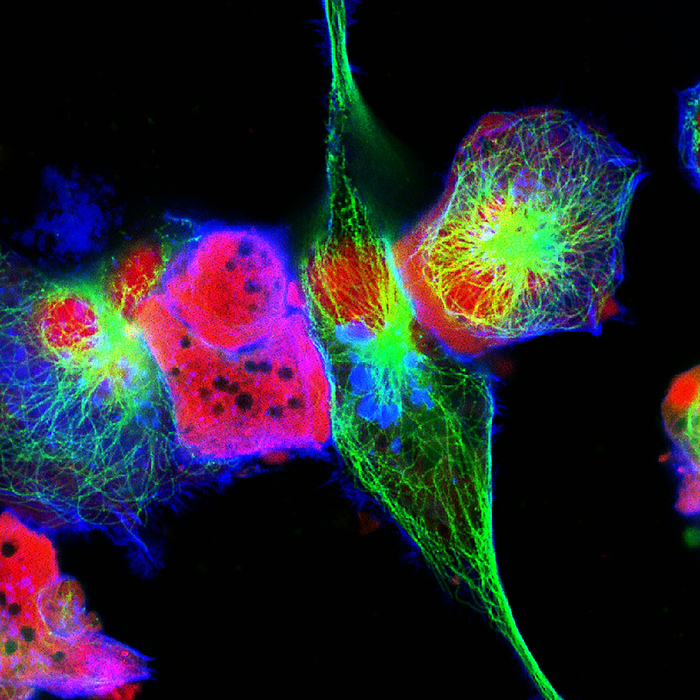A nurse performs a coronavirus test in India DPA via Europa Press / Europa Press
A new variant of the coronavirus circulates through India as the country suffers the worst wave of infections and deaths that the world has seen since the beginning of the pandemic.
Almost everything about this new version of the virus is still unknown, while its expansion is exponential and already accounts for 50% of the cases detected in some State.
The Indian variant - B.1.617 - was first identified in the autumn of last year, around the same time as the UK variant.
The British version is prevalent in many European countries and also in India, and is 90% more contagious and up to 58% more deadly.
Of the Indian variant, three mutations are concerned within the sequence of 30,000 RNA letters that make up its genome.
A single change of one of those 30,000 genetic letters can make SARS-CoV-2 better invade the body's organs and escape the effective ones of the immune system that could eliminate it.
India fights practically blind against the new variants
The name of the mutations is read as a license plate and indicates the exact point of the letter change. The most worrisome of the Indian virus is L452R. It means that the virus has evolved to change a leucine —L— for an arginine —R— at position 452 in the genome. This is precisely the location of the receptor-binding domain, the point of attachment between the virus and the human cell. This mutation has already appeared in another variant of the virus detected in California. It made it 20% more infectious, increased its replication capacity, and allowed it to escape some of the antibodies developed by those infected.
The Indian variant carries a second worrying change just in this region, the E484Q, whose potential is unknown.
There is a third mutation that generates alarm, P681R, as it can optimize the process of entry of the virus into the cell and increase its ability to invade tissues.
These three changes may make the Indian variant more contagious and virulent, but there is no evidence yet.
Data from the Indian Government show that this variant is already prevalent in the state of Maharashtra, in the center of the country.
The prevalence of this version is growing exponentially in recent months, just since the second wave began in the country where the virus is killing more than 2,600 people every day.
A study in India shows that the national vaccine Covaxin neutralizes the new variant
The big problem is that India is fighting almost blindly against the new variants, since it barely sequences the genome of 1% of positive cases.
This implies that the prevalence of the different versions of the virus in the entire country, with a population of 1.3 billion people, is practically unknown.
As a comparison, one of the countries with the most sequence of viruses, the United Kingdom, analyzes 10% of the cases.
The Indian variant has already reached 19 countries.
Almost all are isolated cases, mostly travelers arriving from the Asian country.
Spain is investigating a possible first case in the Valencian Community, according to Fernando González-Candelas, co-director of the virus sequencing program.
The Ministry of Health has imposed a 10-day quarantine on travelers arriving from India from Saturday.
The World Health Organization has warned that this new variant could be more contagious and partly escape vaccines.
But for now he has described it as a "variant of interest" and not as a "worrying variant", a list that includes versions from the United Kingdom, Brazil, South Africa and California, of which there is evidence that they are more transmissible or virulent and they can significantly reduce the effectiveness of some vaccines.
Blood serum from people who have already passed the infection neutralizes the new variant without problems, according to a recent preliminary study led by the National Institute of Virology of India.
The work also shows that the Covaxin vaccine developed in this country from inactivated viruses and approved since the beginning of the year also neutralizes the new variant.
India and other countries will now conduct the tests to show whether the three worrisome mutations of this variant have an impact on the infectivity of the virus.
They will do so both in laboratory experiments and in observational monitoring of the pandemic wave.
Most experts ask that the importance of this new variant in the exceptional second wave that the country is experiencing should not be exaggerated.
"I doubt very much that it has a great role," says Iñaki Comas, geneticist and co-director of the virus sequencing program in Spain.
"It is not that the Indian variant causes the wave, it is the wave, the high transmission, which favors the appearance of these variants," he highlights.
B.1.617 has been circulating since autumn and three subvariants are already known, one of them without one of the most worrisome mutations. The fact that it has been circulating for so long questions that it is very transmissible, explains Comas. “This new variant is going to have very difficult to compete against the one of the United Kingdom because this one is transmitted a lot. In this sense, it is good for India to be dominated by this variant, because it has been shown that both the immune system and vaccines neutralize it well, "he adds.
India controlled the first wave of the virus well. Afterwards there was a certain relaxation of the control measures, massive religious festivities and sporting gatherings were allowed while the English variant, more infectious and deadly, spread. Knowing what exact role the new variant is playing in this situation is "very difficult," admits Isabel Sola, virologist at the National Center for Biotechnology. "This new version of the coronavirus is no more worrying than those already detected," he explains. “It is important not to raise your guard, because the way to combat them is always the same; do not let the virus spread widely. Some of the mutations in this version can cause the virus to escape a specific type of antibody, but the immune system produces many types of antibodies and immune cells.you never play a card ”, he emphasizes.
Right now humanity is fighting the decisive battle against the coronavirus.
Vaccination of most of the population corners the pathogen until it has nowhere to take refuge.
The virus continues to accumulate random mutations that can help it survive.
"The longer it takes to finish vaccinating, the more likely it is that a new version will emerge with one or more mutations that give it a dangerous advantage," recalls Marcos López, president of the Spanish Immunology Society.
You can follow MATERIA on
,
and
, or sign up here to receive
our weekly newsletter
.

/cloudfront-eu-central-1.images.arcpublishing.com/prisa/IRM4JHFNKI64ZTZD23CFKURPIQ.jpg)







/cloudfront-eu-central-1.images.arcpublishing.com/prisa/GLQIPWOC3VBT3BKZRNAZOQJEQU.jpg)